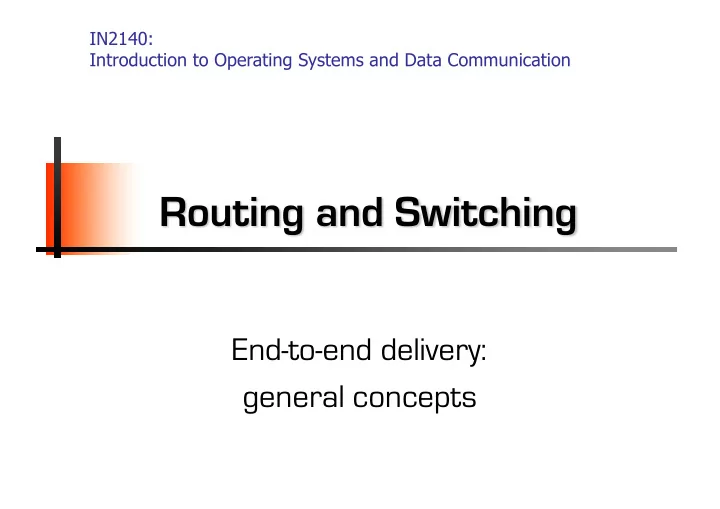

IN2140: Introduction to Operating Systems and Data Communication Routing and Switching End-to-end delivery: general concepts
Circuit switching [ H a r r i s & E w i n g , 1 9 0 5 ] Principle § Connection exists physically for the duration of the conversation § Refers to − Switching centers − Connections between switching centers (frequency spectrum, dedicated ports) § Implementation examples − Historically: on switching boards − Mechanical positioning of the dialers University of Oslo IN2140 – Introduction to operating systems and data communication
Circuit switching − Today: optical networks (e.g. WDM) Principle § − Setting coupling points in circuits Connection exists physically for the duration of the conversation λ 1 λ 2 Opto-VLSI Processor § Refers to − Switching centers a. Switching principle − Connections between switching Mirror centers Output pixel blocks/Second beamsteering (frequency spectrum, dedicated ports) Input pixel blocks/First § beamsteering Implementation examples Opto-VLSI Processor − Historically: on switching boards Grating Fiber Collimator Plate Lens 1 Lens 2 Array − Mechanical positioning of the dialers Mirror b. Side view [from “Opto-VLSI-based N × M wavelength selective switch”, DOI 10.1364/OE.21.018160] University of Oslo IN2140 – Introduction to operating systems and data communication
Circuit switching − Today: optical networks (e.g. WDM) Principle § − Setting coupling points in circuits Connection exists physically for the duration of the conversation § § Refers to Properties − Switching centers − Connection has to occur before transmission − Connections between switching − Establishing a connection takes time centers (frequency spectrum, dedicated ports) − Resource allocation is rigid (possibly § waste of resources) Implementation examples − Once connection is established it − Historically: on switching boards cannot be blocked anymore − Mechanical positioning of the dialers University of Oslo IN2140 – Introduction to operating systems and data communication
Packet Switching Principle § Packets of limited size § Dynamic route search (no connect phase) § No dedicated path from source to destination Data to Multiple Users Destination Node F Node D Node B Node E Data Example: Internet From Node A Multiple Users Source Node G Node C : Packets § Properties − Possibly only reservation of average bandwidth (static reservation) − Possibility of congestion − High utilization of resources University of Oslo IN2140 – Introduction to operating systems and data communication
Comparison: Circuit and Packet Switching § Circuit switching § Packet switching − Connection establishment can − No connect phase take a long time − No allocation of bandwidth − Bandwidth is reserved • Danger of congestion • No danger of congestion • Potentially 100% bandwidth utilization • Possibly poor bandwidth utilization (burst traffic) − constant transmission time − varying transmission time − all data is transmitted over the − packets between same end same path systems may use different paths University of Oslo IN2140 – Introduction to operating systems and data communication
Virtual Circuit Switching Principle § Setup path from source to destination for entire duration of call − Using state information in nodes but no physical connection − Connection setup: defines data path − Messages: as in packet switching, but: • No routing decision per packet • Simpler addressing: associate with virtual circuit instead of destination § Properties − Possible to ensure Quality of Service − Possible to maintain order of packets IPv6 Header Version DSCP ECN Flow label Flow label for virtual circuit Payload length Next header Hop Limit identification: Source address • shorter than destination (128 bit) address • received earlier than destination Destination Address address (128 bit) L4 Data University of Oslo IN2140 – Introduction to operating systems and data communication
Comparison: Virtual Circuit and Packet Switching § Virtual circuit switching § Packet switching − Connection establishment can − No connect phase take a long time − No allocation of bandwidth − Bandwidth can be reserved • Danger of congestion • Provider can guarantee loss • Potentially 100% bandwidth probability of package losses utilization and probability of waiting times • Better bandwidth utilization than circuit switching − varying transmission time − varying transmission time − all data is transmitted over the − packets between same end same path systems may use different paths University of Oslo IN2140 – Introduction to operating systems and data communication
Message Switching very rare at L3 today: Principle just for completeness § All data to be sent are treated as a "message" § some applications on L5 “Store and forward" network: operate like this in each node the message is handled as follows: 1. Accepted (L2 frames are collected until L3 message is complete) 2. Treatment of possible errors 3. Stored 4. Forwarded (divide into several L2 frames for sending to the next node) § [secretlondon123@flickr, CC BY SA 2.0] Ancient history − dial-up networks − and its protocol UUCP – Unix to Unix Copy § Recent research − delay-tolerant networks, e.g. NASA Deep Space Network § Properties [NASA/JPL-Caltech] − High memory requirements at the node (switching centers) • message size is unlimited • usually stored on secondary repository (harddisk) − Node may be used to its full capacity over a longer period of time by one message University of Oslo IN2140 – Introduction to operating systems and data communication
Recommend
More recommend